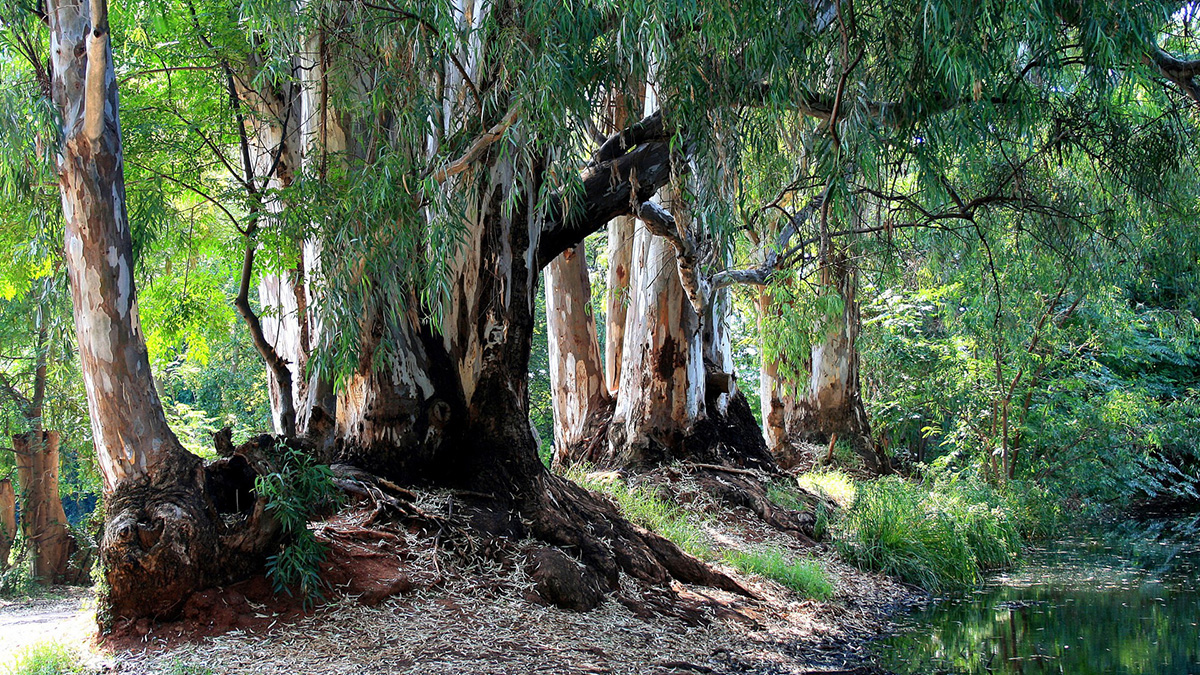Humans have an unfortunate tendency to view the peculiarities of their particular time and place as a kind of immutable standard. But, as Heracleitus wrote so long ago, “all is flux”. Change is the only constant in nature. Too many Australians today think that the “natural” state of the land is the dense eucalypt forests they’re familiar with in Australian national parks. But that’s not the landscape that typically greeted the first Europeans.
The landscape of 1788 was mostly very different from today: open, grassy plains dotted with wide-spaced trees: “Like an English park”. But, even that landscape was one that had been moulded over millennia from dense rainforests. The tale of the changing Australian landscape is one of a gradually-dominant species – a species which is key to Australia’s predisposition to wildfire.
Fossil evidence suggests that eucalypts originally emerged from our Australian rainforests and then quickly spread and conquered virtually the whole of Australia, with botanists recognising that every variety of plant community in Australia, be it heathland, scrub, open woodland or forest, is dominated by a variety of eucalypt, the only exception being the very dry inland that is still dominated by acacias.
What evolutionary strategy do eucalypts use, which makes them so successful?
Basically, eucalypts can survive an intense fire when few other species can; and since they can survive fire they can afford to encourage fire because it will eliminate competition from other species.
In fact, natural selection has seemingly led to eucalypts actively cultivating fire […]Eucalypts are essentially fire-fuelling incinerators that generate so much heat when they catch fire that when one burns its radiant heat evaporates the oils in the neighbouring eucalypts creating a flammable gas which ignites as a fireball, and so the crowns of the trees explode with fire one after the other, triggering a ‘crown fire’—a wave of exploding eucalypt canopies that race through the Australian bush like a tornado.
But, to exploit their evolutionary advantage, eucalypts need fires to start. Lightning can and often does so – but not nearly enough to explain eucalypts’ dominance. Instead, eucalypts found a prolific new firestarter washing up on their shores some tens of thousands of years ago.
‘Fires lit by Aboriginal men and women created the landscape of Australia[…]’
Evidence that the fire-adapted eucalypts spread in parallel with the arrival and spread of Aborigines is supported by an article on the history of Australian flora which said that ‘the gums are […] all but absent until a few tens of thousands of years ago’ […] If fires from lightning strikes had been numerous enough to allow for the proliferation of eucalypts and the development of our current fire-weed, gum-tree monoculture then surely it would have appeared much earlier in the fossil record.
That propensity of eucalypts to foster intense fires has an obvious implication for Australian town-planning and land use. But, it’s one that is going to shock many Australians who dream of a “home among the gum trees”.
Eucalypts have to be viewed as extremely dangerous incinerators that must be kept away from residential and commercial zones. They are not like other trees that we can surround ourselves with because of their natural beauty or shade qualities. Rather (and greenies especially should note this) we have to view eucalypts as being like dangerous crocodiles planted tail-down ready to destroy lives and our world—including so much of our wildlife […] eucalypt forest fires are so frequent, ferocious and destructive that eucalypt forests actually represent a lost part of our continent. Humans can’t live near them, and they are an extremely dangerous habitat for wildlife.
spectator.com.au/2020/01/the-science-of-bushfires-is-settled-part-2/
As Californians have discovered if you plant eucalypts in quantities the fires will come. Australians are going to have to learn the same lesson. Just because eucalypts are native to Australia, doesn’t mean that they can’t be a danger to the environment. As places like Kangaroo Island and Canberra have discovered, left to breed out of control, native animal species like koalas and kangaroos can quickly become as destructive to the environment as any introduced pest.
Don’t get me wrong: I love eucalypts. But I learned, from my earliest days camping, not to trust them. “Never pitch your tent under a gum tree,” was the stern advice I was given as a child, referring to their propensity for shedding branches. The same caution must apply to planting eucalypts anywhere near human habitation. It also means we must re-cultivate a regular regime of smaller, cooler fires – literally, fighting fire with fire – in order to prevent the sort of destructive mega-fires we have seen.
If you enjoyed this BFD article please consider sharing it with your friends.

